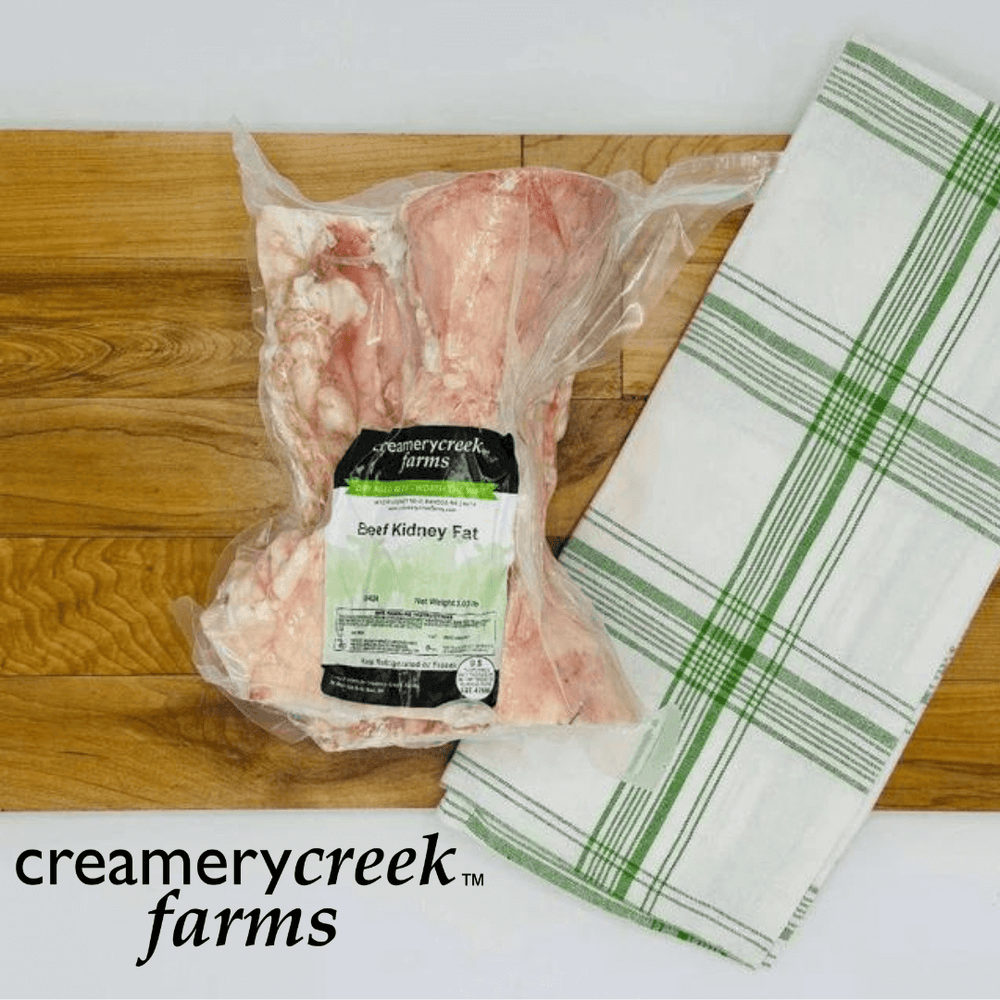
Rendering beef fat into tallow might sound intimidating, but trust me—it’s one of the easiest ways to level up your cooking, or skin care routine, and the results are worth it!
If you've ever bought tallow from the store and wondered if you could make it yourself, the answer is yes! And with clean kidney suet, like the kind we offer at Creamery Creek, you don’t even have to worry about the usual mess. You can go from fat to golden tallow with very little effort, and I’m going to show you how. Grab your Crockpot—it’s time to get rendering!
Why Render Suet?
You might be thinking, “Why bother with this when I can just use butter or oil?” But here's the thing—tallow, made from rendered suet, is a total game-changer. It’s got a high smoke point, meaning you can fry, roast, and sear without burning it. Plus, it’s shelf-stable and packed with healthy fats like omega-3s. But what I really love? You’re making the most of every part of the animal, honoring the work that went into raising it. With our suet, you don’t even have to trim off extra bits or fuss with rendering out impurities—just melt and go!
Step-by-Step: How to Render Suet in a Crockpot
-
Prep the Suet
Even though our suet is super clean (seriously, no need to trim it!), I recommend cutting it into small pieces. Smaller chunks melt faster and more evenly. Don’t worry about making them perfect—just grab a sharp knife and chop them up into rough cubes. If you want to speed things up, toss them in a food processor and pulse a few times. You’ll have suet ready for rendering in no time! -
Set Your Crockpot
Now, the magic begins. Put your suet in the Crockpot and set it on low. This part is important—slow and steady wins the race here. High heat can scorch the fat and leave you with a batch that tastes off. So resist the urge to crank it up! Depending on how much suet you’re rendering, it’ll take anywhere from 4 to 8 hours. You’ve got time to go about your day while your Crockpot does the work. -
Stir Occasionally
You don’t need to babysit the Crockpot, but give it a stir every couple of hours. This helps the fat break down evenly and keeps the temperature consistent. Soon, you’ll see that beautiful golden liquid forming, and the leftover solids, called cracklings, will float to the top. Those cracklings? Don’t toss them—they’re crunchy little nuggets of goodness that make a great snack! -
Strain and Store
Once the fat is fully melted and there are no more solid chunks, it’s time to strain it. Grab a fine mesh strainer, line it with cheesecloth, and pour the liquid tallow through it into a clean jar. Make sure to use something heat-safe like a glass mason jar. The tallow will cool and harden, turning creamy white and smooth. - Storing Your Tallow
Your fresh tallow can be stored at room temperature for several months, but I like to pop mine in the fridge or freezer for longer storage. If you freeze it, it’ll last up to a year. And trust me, you’ll want to keep it around—it’s such a versatile fat, you’ll be using it in no time.
How to Use Your Homemade Tallow
Now that you’ve got this jar of homemade tallow, what do you do with it? Oh, so many things!
Cooking: Use it like you would butter or oil. Fry up some crispy potatoes, sear a steak, or roast veggies. The flavor is rich but not overpowering, and it handles high heat like a champ.
Baking: This might surprise you, but tallow works wonders in savory baking. Use it in place of shortening for flaky pie crusts or biscuits. You’ll get a richer flavor and the perfect texture.
Skincare: Tallow is incredibly nourishing for your skin. It has a similar fatty acid profile to human skin, making it a natural moisturizer. I like to whip it into body butter or use it as a base for DIY soap. Your skin will thank you!
Candles: Feeling crafty? Tallow makes long-burning, clean candles. They’re perfect for a cozy, natural vibe at home.
All-in-all
See? Rendering suet is really no big deal, especially when you start with high-quality, clean kidney suet like ours. You don’t need special equipment, and once you try it, you’ll find yourself using tallow in all sorts of ways around the house. Whether you’re cooking up a storm or getting creative with skincare or candles, tallow is one of those old-fashioned staples that deserves a place in every modern kitchen. Give it a try—you won’t regret it!
Tell me how it goes for you!
XO,
Louisa



Leave a comment
Also in Farm Family Recipes
Easy-Peasy Shredded Beef: The Do-Everything Version
Simple food wins every time. This easy shredded beef is gently seasoned, slow cooked until fork tender, and built to flex. Tuck it into tacos, pile it onto warm buns, or stash half in the freezer for later. One beef roast and endless good meals.
Keep reading
Galbi: Korean-Style Short Ribs, Farm-Fresh Flavor
Sweet, savory, and smoky, this Korean-inspired galbi recipe brings a new twist to Creamery Creek’s dry-aged short ribs. Marinate overnight and grill for juicy, caramelized ribs with unforgettable flavor.
Keep reading
Creamery Creek Over the Top Chili Recipe
This chili is not fancy, but it is deeply satisfying.
Our Over the Top Chili starts with a simple large meatball made from Creamery Creek dry-aged ground beef, seasoned just enough to let the beef shine. Instead of browning it in a pan, the whole thing goes on the smoker, perched right over the pot of chili. As it cooks, the beef slowly bastes the chili below, dripping smoky, rich flavor straight into the pot.
Keep reading